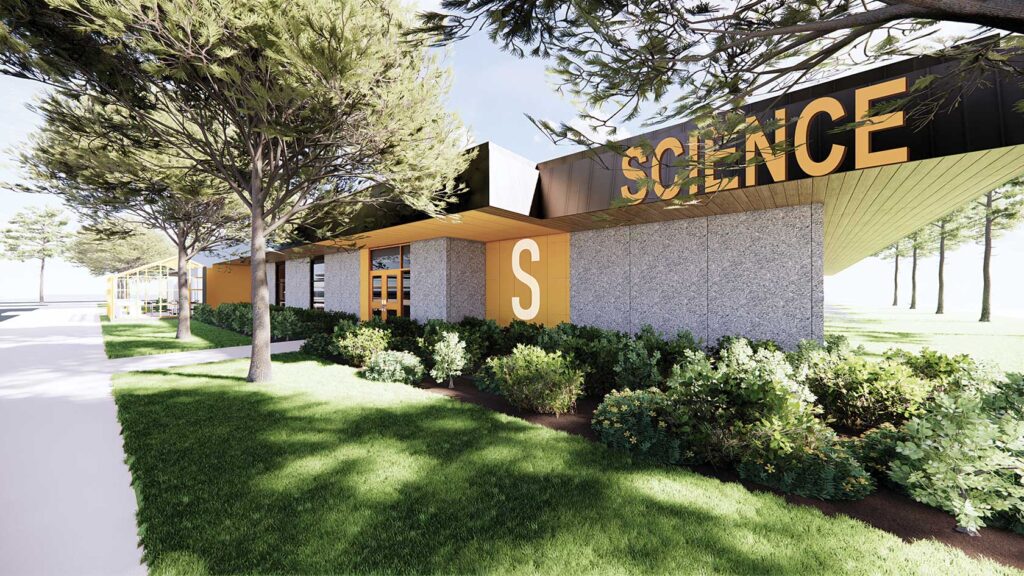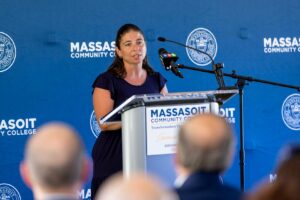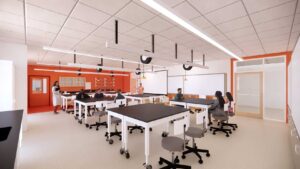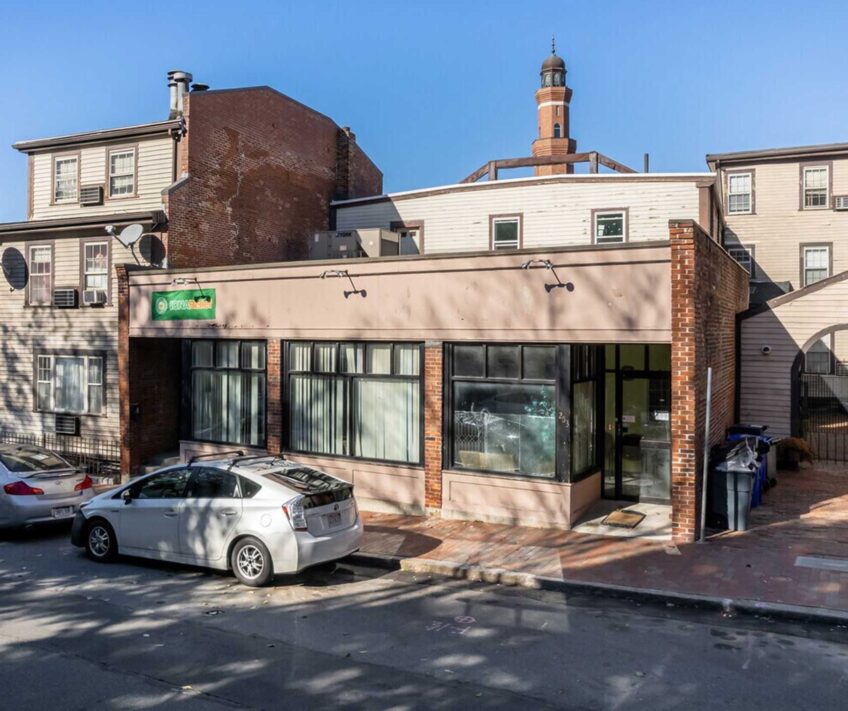New Massasoit Community College science building brings updated lab space to Brockton campus
Facility will foster increased STEM participation, college administration says

For students at Massasoit Community College’s Brockton campus, a $52 million investment means new facilities for the school’s slate of science, technology, engineering and mathematics programming.
The college broke ground on its new science building, which will replace a more-than-50-year-old facility, in a ceremony July 16. Next year, construction is slated to begin on a new health sciences building.
The new construction, which Massasoit leadership said they hope will attract and welcome new students to its STEM programs, comes as across the state, community colleges join a push to help grow and diversify the workforces in fields like the life sciences, information sciences and climate-related spaces.
The science building is expected to open in fall of 2026. The health science building is expected to be completed in time for the fall 2027 semester.

Katie Ruggieri, dean of MCC’s science and math division, speaks at the groundbreaking ceremony. PHOTO: MASSASOIT COMMUNITY COLLEGE
The new buildings will be better situated to serve students and increase access to the school’s STEM programming, said Katie Ruggieri, Massasoit Community College’s dean of the school’s science and math division.
The updated space will be better designed to house the program’s research equipment and will be furnished with new whiteboards. The existing science building still uses some chalkboards. The space will be designed to have better storage and increased technology, like microscopes that can hook up directly to a computer to display on a screen or projector, rather than needing each student to look through the eye piece.
The current building has served the school’s science offerings well, Ruggieri said, but can’t fully match the program’s modern needs.
“They have obviously done their best, but they’re struggling to keep up with the modern demands like what we need in the lab and such,” she said.
As the program has grown and gathered new equipment, it has maxed out the labs’ electrical capabilities. Its current infrastructure presents other limitations, such as the limited visual range on the projector set-ups.
Storage space is also currently limited, so items are stashed under desks and on counters. The new building will include storage in other places, like hidden behind whiteboards, to create a cleaner look in the labs.
All of that, Ruggieri said, should improve operations of the school’s STEM programming, which includes a research program focused on local pollinators, where students and staff work on looking at the genetics of bees and the pollen they carry. That research program was launched about 10 years ago.
Jones Architecture, which is working on the project, has worked with the school to match their needs, Ruggieri said, and has shown best practices from other lab spaces and STEM projects elsewhere. And staff input has helped shape how the project was planned.
“We’ve learned lessons from the past decade about what we need, so we’ve had a larger input into their design versus, I’m assuming, when the school was first built,” Ruggieri said.
In addition to those steps toward modernization, Ruggieri said that the design for the new space is all about making it a “warmer learning environment” that is more accessible and inviting.

An architect’s rendering of a lab space in the planned new science building at Massasoit Community College. PHOTO: MASSASOIT COMMUNITY COLLEGE
The building, she said, should be proudly a science building while trying to lean away from a design that comes across as cold or sterile. And inside, it’ll be open, so a student who might be there for a general biology course can see the paid technicians working in the labs and consider what other opportunities might be out there.
“The hope is that it’s a more inviting building overall, and it gets them more jazzed to jump into some of these career programs,” Ruggieri said.
That sort of step can be an important one to make sure that students feel welcome and comfortable, especially in STEM fields, which have “something of a fearsome reputation,” said Bill Heineman, chair of the Community College Council of Presidents.
“It’s crucial that the facilities that students are learning in are designed in a way that makes them feel comfortable, that makes them feel at home,” Heineman said.
The effort at Massasoit to make the building more welcoming is part of a broader effort from the community college to increase access to the STEM workforce, which they’ve tried to tackle through a research program focused on native pollinators — something Ruggieri said is uncommon for community colleges like Massasoit — as well as a more recent push to create and expand micro credentials, small degrees with a shorter timeline and fewer requirements than an associate degree or a certificate that focuses on a specific skill employers might be looking for in the life sciences space.
Similar efforts are taking place in community colleges across the state.
Roxbury Community College has partnered with the Massachusetts Clean Energy Center to launch an energy auditor program to introduce local students to that developing career field. And across the Boston region, in 2024 the city announced $4.7 million in funding for life science training programs, many of which are housed at community colleges.
That sort of programming can help create more access to a broad array of jobs that exist across Massachusetts, and often have vacancies, said Heineman, who also serves as president of North Shore Community College in Danvers.
“No matter what part of the state you’re in, STEM-related business and employers are a significant portion,” he said.
Connecting students to those roles can help the local community and its economy, which Heineman said is central to the mission of community colleges.
For supporters and staff, those two-year programs offer students a more accessible entry into the education that can prepare them for careers in potentially lucrative fields, compared to likely more expensive four-year programs, and can provide a way to access the education with on-ramps and off-ramps that provide more flexibility as students juggle other life responsibilities.
And community colleges can be more accessible to communities of color and groups less represented in STEM fields. According to data from the state’s Department of Higher Education, students of color made up about 59% of community college enrollees in the fall of 2024, but 37% of state university enrollees.
Black students made up about 16% of the student bodies at community colleges, but 9% in state universities, while Latino students made up about 26% of community college students and 15% in state universities.
“The community colleges serve a much larger percentage of students of color than the rest of the higher ed sector in Massachusetts,” Heineman said. “We naturally attract a student body that gives us the opportunity to help diversify that field.”
At Massasoit, that work has also included fostering connections with local high schools, hiring interns and creating a “through line,” from pre-college, through Massasoit to four-year institutions and beyond, Ruggieri said.
She said she hopes that smoother operations in the tailored, new space will help foster that work.
“I’m hopeful that we just, first and foremost, keep up on the momentum that we currently have,” Ruggieri said. “And then we see the sort of the explosion of these micro credentials is what we’re hoping for.”
For Ruggieri, the effort to add the new STEM buildings to Massasoit’s Brockton campus is one step toward that broader goal of fostering and supporting a more diverse workforce.
“We have the infrastructure and now we will have the updated equipment,” Ruggieri said. “It’s kind of the perfect melding for them to really see that they don’t have to go into Cambridge or into Boston to get this training; they can do it right here in Brockton.”






